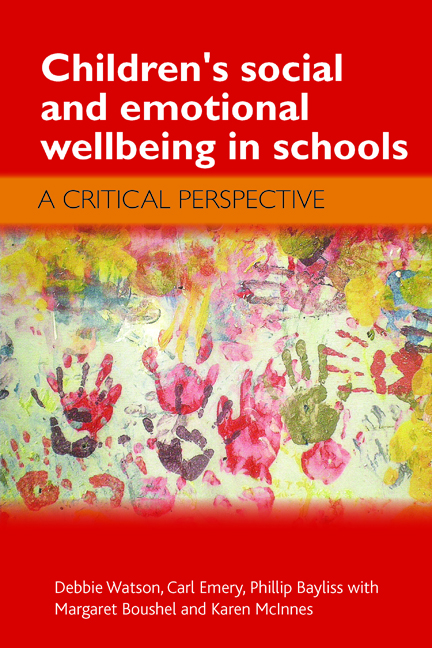Chapter 4 - Practice of social and emotional wellbeing in schools
Published online by Cambridge University Press: 01 September 2022
Summary
Introduction
The decade 2000 to 2010 saw a vast increase in UK school-based programmes that focused on various interpretations of social and emotional wellbeing. These approaches either emphasised building the positive skills and capabilities of young people (resilience, confidence, social skills, self-esteem) or attempted to reduce mental illness, bullying, depression and anxiety (Smart and Vassallo, 2008). A range of labels were applied to these approaches, from ‘emotional intelligence’ (EI) (Goleman, 1995), ‘emotional literacy’ and ‘emotional health and wellbeing’ (EHWB) to ‘social and emotional wellbeing’ (SEWB) (DCSF, 2005), and ‘social and emotional dispositions and skills’ (SEDS) (Watson and Emery, 2010). Shared objectives were employability, lifelong learning, relationship building, improved behaviour and academic achievement.
The creators of these school wellbeing programmes ranged from independent private organisations through to local authorities, individual schools, not-for-profit social agencies, charities and universities. A 2007 report produced by Futurelab and the Qualifications and Curriculum Authority (Facer and Pykett, 2007) highlighted 19 programmes running across the UK, noting that many others existed. The combined impact of all of these, however, is negligible compared to the main subject of this chapter: ‘Social and Emotional Aspects of Learning’ (SEAL) (DFES, 2005c, 2007b, 2007c).
What are Social and Emotional Aspects of Learning?
SEAL first emerged as ‘Social, Emotional and Behavioural Skills’ (SEBS), part of the National Behaviour and Attendance Pilot in 2003 (Hallam et al, 2006). By 2007, it was delivered in more than 80% of primary schools and, by 2010, in 90% of primary and 70% of secondary schools across England, a high rate of coverage for a non-compulsory programme (Mills, 2009). Guidance documents, learning materials and background papers were placed on the now defunct National Strategies website (DfE, nd).
Taking Every Child Matters as its policy template, Promoting Emotional Health and Wellbeing through the National Healthy School Standard (DH and DfES, 2004) set out the framework for SEAL. This report explicitly linked improvements in child wellbeing with the development of their social, emotional and behavioural skills. It defined EHWB as ‘a holistic, subjective state which is present when a range of feelings, among them energy, confidence, openness, enjoyment, happiness, calm, and caring, are combined and balanced’ (Stewart-Brown, quoted in Weare and Gray, 2003, p 19).
- Type
- Chapter
- Information
- Children's Social and Emotional Wellbeing in SchoolsA Critical Perspective, pp. 57 - 76Publisher: Bristol University PressPrint publication year: 2012

